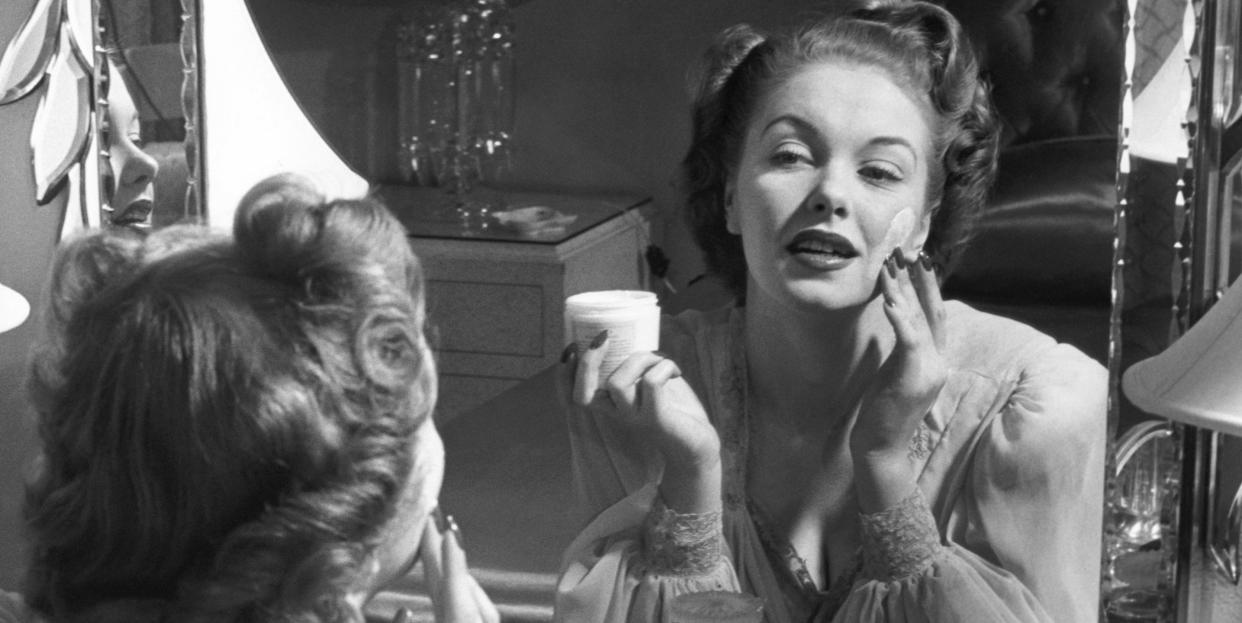Why Cold Cream Is Suddenly Hot

To determine what texture we’re touching, our brains conduct what neuroscientist Sliman Bensmaia describes as a neural symphony, with dozens of different attributes—slipperiness, temperature, density, on and on—sent from 20,000 nerve fibers in the skin. Compare this to how we identify a color, interpreting just three attributes: hue, saturation, brightness. For a beauty aficionado, the teeniest tweak to just one of these color dimensions will create an entirely new shade (which explains why I have 231 same yet different red lipsticks). But when it comes to skincare, humans have predominantly preferred one specific textural neural symphony for almost 2,000 years: that of a soft, thick, comforting cream.
Cold cream, specifically, is history’s vanity OG, a multitasking moisturizer, cleanser, and balm that our ancestors’ ancestors slathered on with zeal. “It’s the Big Momma of skincare,” says dermatologist Ava Shamban. “If you look at the most ancient versions, such as from Egypt, cold creams were made to nourish the skin.” Around AD 170, Greek physician-philosopher Galen codified the recipe—a simple blend of beeswax, olive oil, and rosewater that you churned and churned until, as with mayonnaise or meringue, you created a sum much fluffier than its parts.
“Cold cream was originally very nutrient-dense,” Shamban says. “But then it became mass-produced in the 19th century with petroleum jelly and mineral oil, ingredients that don’t provide any nourishment. So in the States these types of cold creams became viewed strictly as cleansers.”
And what a cleanser! We have cold cream to thank for Kleenex, which was invented in 1924 as a hygienic way to remove it from the face. Cold cream advertisers encouraged magazines to launch the first beauty sections. In the ’20s Pond’s created what could be considered the world’s first skinfluencers, signing European royals and Vanderbilt Row It girls, as well as social activists, as spokeswomen. By the ’30s, cold cream was ubiquitous on movie sets, both behind and in front of the camera, and its popularity persisted through the 1960s (both Marilyn Monroe and Jackie O were devoted to Pond’s).
“Cold cream is both lipophilic and hydrophilic, so the oil sticks to the dirt and sebum in the skin, and then water helps rinse it all away,” says Libby Banks, co-founder of the Seated Queen. Shamban notes that cold cream shouldn’t clog pores, and anyone using potent actives could benefit from switching to a cold cream cleanse: “It can help maintain a healthy skin barrier as well as prevent irritation and dryness caused by retinol or acids.”
“There’s a hugely glamorous side to cold cream,” says Stephen de Heinrich de Omorovicza, founder of Omorovicza Budapest. “I grew up loving classic movies, and I always associate cold cream with those screen sirens, amazing Hollywood actresses sitting at some vanity, smoking, drinking, and having an argument while applying cold cream.” Now his Queen Cleanser, a decadent whip of sweet almond oil, soothing calendula, and Omorovicza’s signature Hungarian thermal water, is part of a new generation of creams that combine that stone cold glamour of Old Hollywood with the comforting, skin-cocooning nutrition found in Galen’s original recipe. Queen Cleanser is intentionally packaged in a generous jar, de Omorovicza says, “so you can really go for it, get a really big four-finger scoop in your hand. There’s something about the gesture, the texture, the ritual that I find compelling and immensely cool.”
He’s not alone. Some iterations, like Avène’s best-selling Cold Cream hand salve, have been pharmacy staples in France for years (the French love a crème doudoune—named after the puffiest, coziest kind of down jacket). But there has also been a tremendous resurgence in the popularity of cold cream, which is popping up all over social media feeds and new product launch rosters. Cold cream is dopamine dressing applied to the skin. On days when I need an extra hug from the world, I use a ping-pong-ball-size scoop of one of my favorites, such as Paul & Joe super-velvety Cleansing Cream (which I once saw a K-pop star smearing on her face during a long-haul flight), and massage away.
The Seated Queen co-founders, fashion journalist Banks and her sister Josephine, a fashion buyer, set out to formulate a face wash that wouldn’t aggravate Josephine’s eczema. By replacing traditional mineral oil with the same healing oils found in top luxury facial oils—borage, argan, rosehip seed—they invented something much more, a deeply soothing all-in-one cleanser--moisturizer-mask. “Our a-ha moment was when we realized that with the right high-quality ingredients, you could use a beautiful cold cream in many different ways. If you put it on dry skin and remove it with a damp cloth, it works as a gentle but effective cleanser. If you put it on damp, cleansed skin and leave it on overnight, it can do something completely different. The amazing oils penetrate, and you wake up deeply hydrated.”
Can one jar really do it all? “Yes, if it contains nutritious ingredients, 100 percent,” says Shamban. “That’s the magic of cold cream.”
This story appears in the March 2023 issue of Town & Country. SUBSCRIBE NOW
You Might Also Like

